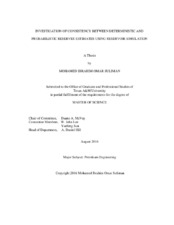| dc.description.abstract | Over time, oil and gas producing companies have used various techniques and approaches to estimate their hydrocarbon reserves. Their approaches are set according to their own internal business needs and/or according to their interpretation of the regulatory requirements.
Reservoir simulation has been used more commonly as an optimization, production forecasting, and reservoir management tool than as a reserves and resources estimation tool, particularly for reserves estimates provided to regulatory agencies. Deterministic and probabilistic reservoir simulation approaches for reserves estimation are currently in practice with different procedures. The problem is that there is usually inconsistency in estimates from the different methods.
The objective of this work was to determine how to estimate reserves using reservoir simulation with both deterministic and probabilistic approaches such that the resulting reserves estimates from the two approaches are consistent with one another in some way. Since all the simulation runs were terminated at a fixed simulation time instead of an economic limit, the production calculated is technically not reserves. The recovery from the end of history to the end of prediction, i.e., the quantity that was recovered for the 8.5 years of prediction, was termed ROP and was used as an approximation for reserves in this study.
In this study, a distribution of the ROP estimate was generated using multiple simulation models with the probabilistic approach. A deterministic ROP estimate was derived using the simulation model that has the best history match out of the simulation models that were generated using the probabilistic approach.
It is concluded that the consistency between the deterministic and probabilistic reserves cannot be guaranteed and it is hard to say where exactly the deterministic reserves will fall on the probabilistic reserves distribution. The consistency between the deterministic and probabilistic reserves is controlled by the relationship between reserves and the uncertain parameter, the relationship between the uncertain parameter and mismatch objective function (OF), and the acceptance threshold of the models to be included in generating the reserves distribution.
Therefore, deterministic reserves estimates should be used with caution, as it is uncertain which reserves categories the deterministic estimate represents for any situation. | en |


